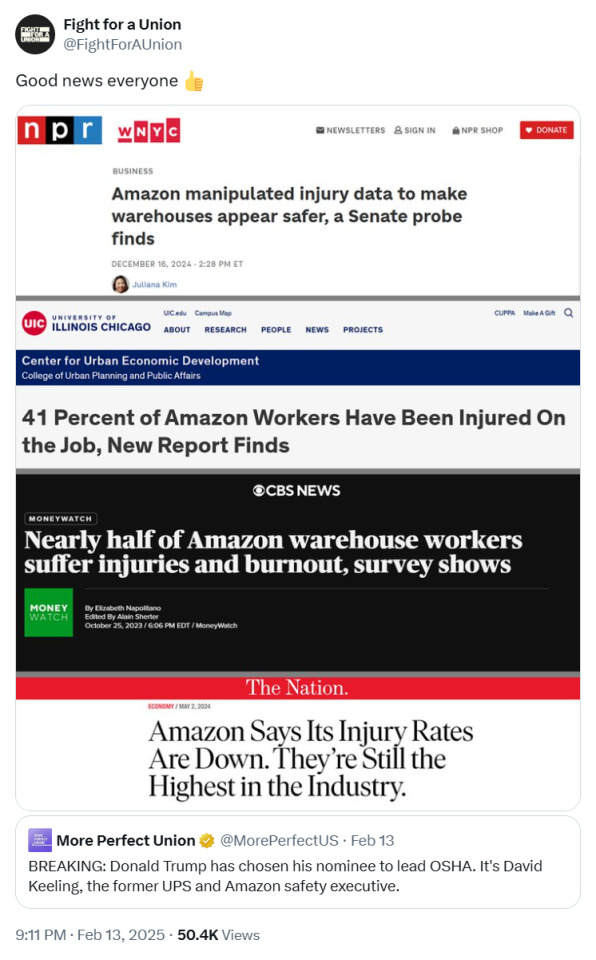#Occupational Safety and Health Administration (OSHA)
Explore tagged Tumblr posts
Text

OSHAwott
42 notes
·
View notes
Text
would love to write a romance book where the main characters' names are noah and iris and everyone loves it and it gets super popular and people are obsessed and are posting meta about it and someone asks me on twitter (i get a twitter specifically in preparation for this) why i chose the names noah and iris. they have done the research and know that noah means both 'to rest' and 'in motion' which encapsulates his character, while 'iris' means rainbow which could be a nod to her being queercoded, which many readers have picked up on. i reply that noah is NOAA, the National Oceanic and Atmospheric Administration, and iris is IRS, the Internal Revenue Service. i never again answer another question about this
#kit to kit#morning thoughts with kit before she finishes her coffee are like#their best friends are Dea and Osha btw#(Drug Enforcement Agency and Occupational Safety and health administration)
60 notes
·
View notes
Text

#workplace injury#amazon#osha#occupational safety and health administration#the trumpocalypse#convicted felon trump#adjudicated sex offender trump
5 notes
·
View notes
Text
youtube
V-Tuber talks about how the Trump Administration is repealing OSHA. And yeah, ITS A REAL FUCKING THING.
Arizona Congressman Andy Biggs sponsors bill to abolish OSHA.
Republicans are trying to kill everyone just to line their own pockets.
#osha#Occupational Safety and Health Administration#us politics#human rights#project 2025#donald trump#trump administration#president trump#trump project 2025#trump presidency#andy biggs#arizona#republicans are evil#Youtube
3 notes
·
View notes
Text
Why Was the Occupational Safety and Health Administration Created?
Every worker deserves a safe and healthy work environment. In the United States, this principle is upheld by the Occupational Safety and Health Administration (OSHA), the federal agency responsible for enforcing workplace safety laws. But why was the Occupational Safety and Health Administration created? To fully understand its significance, we must explore the history, purpose, and impact of…
0 notes
Text
OSHA Issues Final Rule on Personal Protective Equipment for Construction Workers, but It Could Start Back at Square One
On December 11, 2024, the Occupational Safety and Health Administration (OSHA) issued a statement that it had finalized a rule amending 29 C.F.R. 1926.95(c) to require construction employers to make personal protective equipment (PPE) available that “properly fits” their employees. Quick Hits On December 11, 2024, OSHA finalized a rule requiring construction employers to provide properly fitting…
#AIHA#American Industrial Hygiene Association#Congressional Review Act#CRA#Federal Register#industry concern#National Institute for Occupational Safety and Health#NIOSH#notice of proposed rulemaking#NPRM#Occupational Safety and Health Administration#OSHA#Personal Protective Equipment#PPE
0 notes
Text
I truly need someone to take firealpaca away from me... in other news, another silly little joke of a design has hit my redbubble:

yeah... yeah. once again, i cannot explain myself, but this webbed site thankfully seems to like osha jokes so i don't think i'd need to explain myself. tumblr sure is a place and unfortunately i love it here. you could get this as a sticker or pin or magnet and i think i left notebooks enabled too bc fuck it, why not.
will i ever make any meaningful good quality sticker designs?? um... no. only shitposts. teehee.
0 notes
Text
I took an OSHA 10 course as part of a certificate program several years ago. For every non-obvious regulation they gave specific examples of the horrific workplace accidents that prompted them. Bonus: if you're not squeamish look up all the worker deaths at Caterpillar plants (still happening afaik) because they didn't have guardrails
I’m still thinking about that “is OSHA regulations Cop Behavior” post. Like. You know who thinks regulations are for losers? People who build submersibles out of logitech gamepads and rejected carbon fibre. People who trust starlink as their only surface lifeline.
Do you wanna be like the fine film on the floor of the Atlantic that was once a billionaire? Is that the hill you’re really gonna die on?
We have an expression in my field- “Regulations Are Written In Blood”
People don’t have fucking safety standards as a power trip, we have them because somewhere in the past, NOT having those regulations killed or maimed someone.
A lot of laws out there are bullshit- safety regulations sure as fuck aren’t. I have the literal scars to prove it.
71K notes
·
View notes
Text
Doing the online OSHA courses are so FUCKING BORING BRO!
IT'S THE MOST MIND NUMBING SHIT IT'S ALL JUST BASIC COMMON SENSE!
Although I guess it's understandable a lot of people seem to struggle with basic common sense.
0 notes
Text
What Are the Types of OSHA Violations?
In 2019, the US Bureau of Labor Statistics reported that over five thousand people were killed due to injuries they obtained while working. Their Census of Fatal Occupational Injuries that same year reported that fatalities had risen five percent in the private construction industry since 2018 and the number was the highest than it had been since 2007.
For 2020, The Occupational Safety and Health Administration (OSHA) released a report of their top 10 violations of the fiscal year. This report included the types of safety violations that most often resulted in injuries and even fatalities at workplaces.
What Are OSHA Violations
OSHA violations happen when a company or one of their employees does not adhere to the proper safety procedures or safety hazards are not addressed. A violation presents a risk for an accident or injury but does not necessarily mean this has happened yet. OSHA will administer inspections that may detect such violations before an incident. In some cases, OSHA may issue the company a fine or citation for the violation. If there is a willful violation and an employee is killed, there may also be criminal charges and penalties involved.
OSHA Violations vs OSHA Citations
Citations are often issued when a company commits a violation that does not necessarily present a danger to their employees. A citation is like a warning that serves to alert the company to the violation and let them know that they need to address it. A citation only becomes part of a company’s safety record if they receive it more than once. If the citation is issued two or more times within three years, it is considered a repeat offense.
Degrees of OSHA Violations
OSHA violations are identified by different degrees of severity. The following designations help determine the amount penalized.
Serious Violations
When a violation is too serious for just a citation, OSHA will also administer fines. According to the OSHA Act Section 17(k), violations are considered serious if they can cause severe injuries or death and should have been reasonably prevented by the employer. OSHA classifies the penalties for these violations on a gravity-based scale categorizing them by their severity with corresponding fines.
High-gravity violations are the most severe and carry fines of $14,502.
Moderate-gravity violations are of middling severity and can carry fines anywhere from $8,287 to $12,431.
Low-gravity violations are lower severity and carry fines for $6,215.
Many companies will hire workplace risk assessment consultants to help them identify these violations before they come to OSHA’s attention.
Other Than Serious Violations
OSHA considers violations that may pose a real risk to the health and safety of the employees, but will not result in injury or death, to be other-than-serious. These violations may incur the same fines as serious violations depending on the situation. In some cases, OSHA may decide to give a citation or reduce the amount of the penalty.
Violations that are considered other than serious are categorized as lesser and greater minimal-only violations. Lesser violations are generally met with a citation and no monetary fine. Greater violations may be met with a fine anywhere up to $14,502.
Willful or Repeated
Repeated violations within a three-year period can be met with fines up to a maximum penalty of $145,027 per violation. For serious repeated violations, the minimum penalty imposed is $10,360. If the violation is other than serious and did not initially warrant a monetary fine then the first repeated violation may be met with a $414 fine, the second with a $1,036 fine, and the third with a $2,072 fine.
A willful violation occurs when the employer is aware of the danger to their employees and ignores it. Fines for willful violations range from $10,360 to $145,027. If a willful violation results in a fatality, the penalty may be a hefty fine, prison time of up to six months, or both. When these fatalities result in criminal convictions, the fines may be as high as $250,000 for individual employers and $500,000 for corporations.
Penalties for serious willful violations may be reduced based on the size of the business and the number of employees.
10 or fewer employees result in an 80% penalty reduction
11-20 employees result in a 60% penalty reduction
21-30 employees result in a 50% penalty reduction
31-40 employees result in a 40% penalty reduction
41-50 employees result in a 30% penalty reduction
51-100 employees result in a 20% penalty reduction
101-250 employees result in a 10% penalty reduction
251 or more employees result in a 0% penalty reduction
Posting Requirements
When OSHA issues a citation or notice of violation to an employer, it must be posted in the area where the violation occurred. The posting must be in full view for all employees for at least three days or until the issue is resolved. These notices are also accompanied by a pamphlet that describes the issue, suggests solutions, and provides the date by which it must be remedied.
Failure to Abate
If an employer does not resolve the issue of the violation by the date provided with the notice, they may be fined for each day past that date that the issue goes unresolved. If the issue was never resolved, it is considered a failure to abate. If the issue was resolved and occurs again, it is considered a repeat violation.
De Minimus Violation
A de minimus violation refers to an issue that is technically a violation in that it does not comply with OSHA standards, but it does not necessarily pose a genuine risk to anyone’s health or safety. Rather than issue a citation or a penalty, OSHA will often provide a verbal warning to the employer and simply note the issue in the company safety file.
OSHA Fines & Penalties
As of January 2022, the following penalties are imposed for OSHA violations:
Serious violations – $1,036 to $14,502
Other than serious violations – $0 to $14,502
Willful or repeated violations – $10,360 to $145,027
Posting requirement violations – $0 to $14,502
Failure to abate violations – $14,502 per day past the abatement date up to 30 days
Can OSHA Fine Employees?
Individual employees are not fined by OSHA for safety violations. The employers are the ones responsible for maintaining the health and safety of their employees and keeping the workplace in compliance with OSHA standards.
Most Common Examples of OSHA Violations
The top ten most frequently fined OSHA violation examples of 2020 are:
Fall Protection with 5,424 violations
Hazard Communication with 3,199 violations
Respiratory Protection with 2,649 violations
Scaffolding with 2,538 violations
Ladders with 2,129 violations
Control of Hazardous Energy with 2,065 violations
Powered Industrial Trucks with 1,932 violations
Fall Protection Training with 1,621 violations
Eye and Face Protection with 1,369 violations
Machinery and Machine Guiding with 1,313 violations
The number one recommended way to prevent workplace incidents is though comprehensive training in OSHA safety standards. OSHA provides 10-hour online safety training courses for both construction and general industry workers. This course helps keep employees informed of the precautions necessary to keep themselves and each other safe.
OSHA also provides an annual report of the most common violations they find in order to give people additional information that can help them maintain safe and healthy work areas.
In 2020 the most common violations were found evenly in both construction and general industry. The list does not change too much from year to year, though the order of the categories may fluctuate.
Fall Protection
Fall protection has been the most commonly cited OSHA violation for ten years. Additionally, falling injuries are also the number one cause of fatalities in the construction industry. There are many ways in which a company might violate the fall protection standard set out by OSHA. Common fall protection violations involve incorrect methods of fall protections being used and the lack of or improper installation of safety features. OSHA mandates fall protection for workers when at a height of six feet or more. It is not enough that the protection be present, however. It must also be in good condition and working order.
Hazard Communication
Some jobs call for the use of chemicals and other hazardous substances. When handling or storing these materials, it is important to know the proper way to do so safely. This is why all hazardous substances must be labeled clearly and accompanied by emergency procedures. OSHA updated and revised their hazard communication standard in 2012 with new criteria and formatting for safety data sheets.
Respiratory Protection
OSHA’s respiratory protection standard serves to protect workers from substances in the air such as dust, smoke, toxic fumes, and other contaminants. Employers are required to ensure that the workplace has proper ventilation and that the employees are outfitted with the correct personal protective equipment.
In the wake of COVID-19, respiratory protection became a major factor with stricter guidelines. So many employers were failing to meet the standards in place that respiratory protection rose to the third most common OSHA violation from its spot at fifth place the previous year.
Scaffolding
OSHA’s data states that approximately 65 percent of construction industry employees work with scaffolding. When handling scaffolding, it is important to adhere to all safety precautions for the safety of those navigating the scaffolding as well as everyone below. The risk of people falling or getting hit by falling objects is a very real danger. Failure to comply with OSHA’s scaffolding standard causes over 4,500 injuries and over 60 deaths annually.
Ladders
The Centers for Disease Control and Prevention reported that almost 60 percent of ladder related fatalities happen within the construction industry. Construction industry ladder violations are generally due to employers not providing the right safety training. Another large issue is when workers use a type of ladder that is inappropriate for the task at hand. OSHA’s Ladders standard provides comprehensive guidelines for ladder safety such as staying within the ladder’s weight restrictions, maintaining proper clearance around the ladder, and ensuring the ladder is steady and secure on the ground.
Control of Hazardous Energy (Lockout / Tagout)
According to data compiled by OSHA, approximately 9 percent of fatalities in the construction industry are related to electrocution, often due to improper energy control during maintenance procedures. Non-fatal electrocution injuries are still serious and can result in burns and even broken bones. The control of hazardous energy standard laid out by OSHA is a guideline for workers to protect themselves from the energy stored in their equipment. OSHA requires that all energy be discharged from machinery properly or controlled by a lockout tagout device.
Powered Industrial Trucks
Powered industrial trucks are heavy machinery such as tractors and forklifts. They are specialized equipment that must be used properly and kept well maintained. OSHA’s powered industrial truck standard forbids anyone from operating these vehicles without proper training. This training includes how to identify and avoid hazards as well as dos and don’ts like not using a phone while driving.
Fall Protection Training
It is not enough that fall protection measures be put in place, OSHA’s training requirements for fall protection standard dictates that any workers who are at risk of falling hazards go through the proper training.
Workers must be properly trained in knowledge of when and where that protection is needed and taught to identify and avoid potential hazards. They must also be taught proper maintenance and operational procedures for all necessary equipment including assembly, disassembly, and safety inspection.
Eye and Face Protection
There are many hazards found in the workplace that leave thousands of people blinded each year. These hazards can be related to debris in the air, toxic substances, and in some professions such as welding, even intense light. The standard for eye and face protection set forth by OSHA provides regulations necessary for preventing injuries to the face and eyes. These regulations pertain to things like eye wash stations and their operational instructions, safety measures applied to machinery, and equipment such as goggles and other protective face coverings.
Machinery and Machine Guarding
Many industries involve the use of dangerous machinery. Proper operation procedures and safety measures are necessary to avoid injury. OSHA’s machine guarding standard provides information to help workers protect themselves from moving parts and apply safeguards where needed.
Avoiding OSHA Violations
Adhering to OSHA standards is not just about avoiding punishment, it is about keeping yourself and everyone around you safe and healthy. Entry level workers are highly encouraged to take OSHA’s ten-hour outreach course in order to learn the information they need to maintain workplace safety. There is also a thirty-hour course that provides more extensive information and training for workers in supervisory or safety-based positions.
One way companies work to prevent OSHA violations is by having a third party come in and perform their own inspection to catch issues right away. It is also good practice for managers and employees to be aware of their surroundings and be on the lookout for any potential violations themselves.
Proactive vs Reactive Approach
Many companies have a reactive approach to health and safety. This means that they only address issues when the issue becomes a problem, or someone forces their hand. This approach can have many negative effects on their workers and even the success of the company itself.
Companies are encouraged to take a proactive approach to health and safety. This means being aware of the rules and regulations set forth by OSHA, keeping management and employees fully trained, and always taking steps to catch and prevent potential violations.
If You Have Been Injured Due to OSHA Violations Contact Mesriani Law Group
It is management’s responsibility to ensure that a workplace or jobsite is conducive to the health and safety of their workers and to prevent injuries. OSHA has rules and regulations in place for a reason and when those rules are violated, people get hurt. Being injured in a workplace accident can be a trying time. Being injured because your boss failed in their duty to protect you can make things much worse. Oftentimes, employers will try to shift the responsibility onto the employee and say they are liable for their own injuries. Having a workman’s compensation attorney can help you navigate the entire process. If you have been injured at work as the result of an OSHA violation, call Mesriani Law Group today for a free consultation.
OSHA Violation FAQs
What are the most common OSHA violations?
Fall protection has been the number one OSHA violation for the past decade. A lack of fall protection means a higher risk of workers falling from dangerous heights. In the construction industry, injuries caused by falling are the most common cause of workplace deaths. Hazard communication has held the second place spot for nearly as long from 2012 through 2020. OSHA dictates strict guidelines for the labeling of dangerous substances and the availability of material safety data sheets containing all relevant product and safety information. Coming in at number three and reportedly stealing the number two spot for 2021 is respiratory protection. Workers must be provided the proper ventilation and PPE to keep them safe from contaminants in the air. A proposed reason for the rise in respiratory protection violations is the rise in regulations during the COVID-19 pandemic.
What are types of violations?
There are a few different types of OSHA violations. Serious violations are ones that pose an immediate threat of injury or death to the workers. Other-than-serious violations are ones that pose a threat to health and safety but may not cause injury or death. De minimus violations are ones that technically violate OSHA standards and regulations but do not pose a direct threat to the workers.
What are the two types of violations?
When a company commits an OSHA violation that is a hazard to the health and safety of their workers, they may be penalized and, depending on the seriousness of the violation, they could end up paying thousands of dollars in fines. If a violation is found that is not necessarily a substantial hazard, OSHA may instead issue the company a citation which is more of an official warning.
#California Employment Law#OSHA#Occupational Safety and Health Administration#Workplace Safety#Workplace Retaliation#Employment Law#Employment Lawyers#California Attorneys
0 notes
Text

EHS Consultants Dubai
#EHS#SafetyFirst#WorkplaceSafety#EnvironmentalProtection#HealthAndSafety#SafetyCulture#OSHA (Occupational Safety and Health Administration)#RiskManagement#SafetyAwareness#SustainableLiving
0 notes
Text


BREAKING: Republican Congressman Andy Biggs has introduced a bill to abolish OSHA. The entire text of the bill reads "The Occupational Safety and Health Act of 1970 is repealed. The Occupational Safety and Health Administration is abolished."
What this bill would mean is the complete elimination of federal workplace safety protections. Millions of jobs in numerous states where the state-level protections are below the federal minimums would immediately become more dangerous.
1K notes
·
View notes
Text
What the actual FUCK?!

Who benefits from this? Corporations, their greedy CEO’s, and their billionaire oligarch owners.
Who suffers from this. The workers and the public.
491 notes
·
View notes
Text
Also preserved in our archive
OSHA calls establishing a common-sense covid prevention standard for healthcare workers "Confusing."
Public health and workers rights die together in a sea of uncovered coughs.
#mask up#public health#wear a mask#wear a respirator#pandemic#still coviding#covid#covid 19#coronavirus#sars cov 2
2K notes
·
View notes
